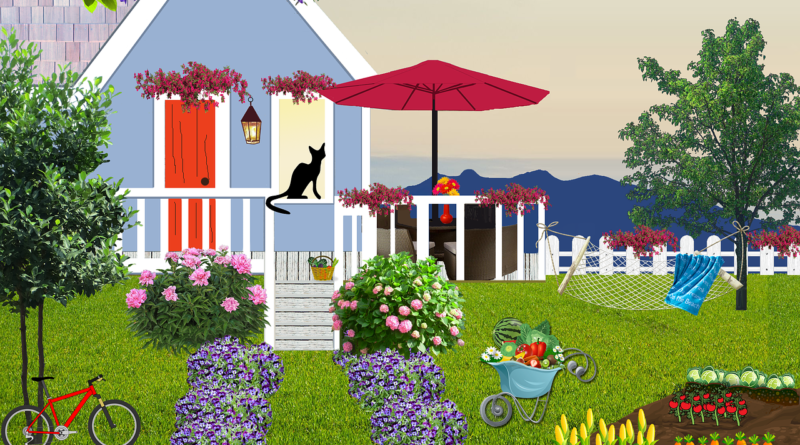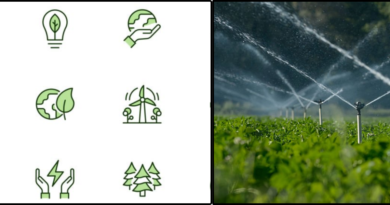Minimalist Gardening: Low-Maintenance Green Space

Introduction:
Minimalist gardening has become quite popular in today’s fast-paced world for those who want to be in nature but don’t want to deal with a lot of upkeep. To produce a beautiful and tranquil green environment, minimalist gardening combines thoughtful planning, deliberate plant selection, and streamlined maintenance procedures.
DEFINITION OF MINIMALIST GARDENING:
Minimalist gardening is a design approach that emphasizes simplicity, functionality, and the intentional use of space to create a harmonious green oasis.To create an aesthetically pleasing and tidy outdoor area, this gardening approach emphasizes thoughtful plant selection, simple layouts, and little decoration. The core ideas are to create a calm and beautiful garden with little work and a deep connection to nature. These include thoughtful plant arrangements, restrained color schemes, and low-maintenance techniques.
This is a comprehensive guide that will assist you in starting the process of creating a low-maintenance garden. or minimalist gardening.
Define your space.
- First, decide which space you would like to convert to minimalist gardening. Knowing your space—whether it’s a bigger garden, patio, or little balcony—is essential for efficient planning.
Clear the clutter.
- Clear out the designated space by taking out everything superfluous. Simplify everything in your garden to make room for the essentials. Minimalist gardens are all about simplicity.
Selecting Essential Plants:
- Choose low-maintenance plants that are appropriate for your area’s climate. Native plants, drought-tolerant species, and succulents are great options. You can make sure your minimalist gardening is in harmony with the environment by researching local flora.
Limited Color Scheme:
- Adopt a restrained color scheme to keep the overall design unified and serene. Calm hues and tones of green provide a calm atmosphere that encourages rest and relaxation.
Strategic plant placement:
- Make thoughtful plans for the design of your minimalist garden. Plants with comparable needs for sunshine and water should be grouped together. It also improves the visual attractiveness of your green area and makes maintenance easier.
Efficient Watering System:
- To reduce water waste, use an effective irrigation method, such as drip irrigationhttps://en.wikipedia.org/wiki/Irrigation. Plants with comparable water requirements should be grouped together to guarantee that each plant gets the right quantity of moisture without going overboard.
Using Mulch to Preserve Wetness:
- To control soil temperature, inhibit weed growth, and preserve soil moisture, mulch around plants with an organic layer. This method reduces the need for frequent watering and enhances the general health of the plants.
Minimal Upkeep Hardscaping:
- Include low-maintenance hardscape components like pebbles, gravel walkways, and simple sculptures. These components enhance the visual appeal without requiring continuous focus.
Operational Furnishings:
- Select comfy and useful outdoor furniture to go with the minimalist gardening design. Choose low-maintenance, long-lasting materials like teak or aluminum.
Frequent Maintenance Schedule:
- A minimalist garden needs less upkeep, although regularity is still required. When necessary, prune plants, clear away debris, and look for pests. Deal with any difficulties as soon as possible to keep them from getting worse.
Seasonal Evaluations:
- To adjust your garden to shifting weather patterns, do seasonal audits. Make the required adjustments to watering schedules, add or remove plants, and make sure your minimalist gardening stays in balance with the natural cycle.
Mindful Garden Decor:
- Give priority to quality over quantity when including accent pieces in your minimalist garden. Choose a few focal items that complement the design’s minimalism. This might be a well-placed bench, a sculpture, or simply well-selected plants.
Using Lighting to Create Ambience
- Use ambient lighting to make your garden usable later in the evening. Select understated, energy-saving lighting solutions to provide ambience without taking over the room. For a minimalist garden, solar-powered lighting is a sustainable optionHow Sustainable Practices Can Extend Your Life.
System of Composting:
- To recycle kitchen trash and improve the soil fertilityhttps://en.wikipedia.org/wiki/Soil_fertility in your garden, use a composting system. Eco-gardening is embraced by minimalist gardening, and composting offers a nutrient-rich, all-natural way to feed your plants.
Promote biological diversity:
- Encourage biodiversity in your yard by drawing in nearby creatures. A balanced environment may be produced by adding bird feeders, plants that attract butterflies, and little water features. This enhances the aesthetic value of your garden and helps maintain a harmonious balance with the surroundings.
Rhythm in Symmetry:
- Adopt a simple, symmetrical landscape design format. To produce a balanced and harmonious visual appeal, arrange plant beds and ornamental components in a line with clear lines. This method strengthens the relaxing impact of minimalist gardening design ideas.
Entire Year Interest:
- Choose plants that provide interest year-round. Plants with distinct textures, attractive grasses, and evergreens guarantee that your landscape looks good year-round with minimal care.
Regular Self-Reflection and Modification:
- Every now and again, give the layout of your garden some thought. Consider if it fits your changing tastes and way of life. A minimalist garden may require adjustments from time to time, and accepting change is an essential part of garden maintenance.
Considerate water elements:
- Select a straightforward and thoughtful design for your water feature if you want to add one to your minimalist garden. A reflected pool or a little, standalone fountain might bring some peace of mind without needing a lot of upkeep. Make sure the water element blends well with your garden’s general design.
Ecological Methods:
- Apply the ideas of simplicity to environmentally friendly gardening techniques. Apply natural pest management techniques, use organic fertilizers, and think about rainwater collection. These environmentally friendly methods improve the resilience and health of your MINIMALIST gardening, in addition to lessening your impact on the environment.
Record your travels.
- To record your observations, experiences, and lessons learned, keep a gardening notebook. You will be able to appreciate how your minimalist gardening has changed over time by having this record, in addition to being a useful resource for future reference.
Getting Used to Change:
- Recognize that as time goes on, your tastes and your minimalist garden will change. Be willing to make necessary adjustments to the general layout, plant choices, and design. This adaptability guarantees that your minimalist gardening will always represent your present aesthetic preferences and way of life.
Digital Resources for Garden Design:
- To organize and maintain your minimalist garden, make use of digital tools. You can see plant arrangements, keep track of watering schedules, and get timely gardening advice using a variety of applications and websites. Technology integration might help to improve the efficiency of your minimalist garden upkeep and expedite the planning process.
Paintings in the Gardens:
- Your minimalist garden’s visual appeal can be enhanced by adding understated artwork. Take into account simple sculptures, garden art installations, or even reused materials that complement the design of your minimalist garden. In addition to giving your green area a distinctive touch, art may be a potent creative expression.
Seasonal Changes in Plants:
- To keep your minimalist garden lively and visually appealing, embrace the idea of periodic plant rotations. Rearrange existing plants or introduce new ones to create new focus points. This gives it some intrigue and lets you play around with different plant combos.
Green Screens for Confidentiality:

- If privacy is an issue, think about utilizing trellises covered in climbing vines or tall, narrow plants as green screens. This leaves your minimalist gardening area feeling private without sacrificing the simplicity of the design, giving you a private haven.
Frequent Testing of Soils:
- To make sure the nitrogen levels in your soil are sufficient for your plants, test it frequently. To maintain plant health and lessen the need for external fertilizers, modify the composition of the soil as necessary. Your minimalist garden will remain sustainable in the long run if you take this proactive approach.
Garden Items Repurposed:
- Incorporate recycled or upcycled materials into your landscape design to embrace sustainability. These ecologically friendly options help create a greener, more environmentally conscious landscape, from rescued trees for raised beds to recycled containers for plants.
Plant Pairings That Make Sense:
- Try combining intuitively chosen plants based on contrasted hues, forms, or textures. This method gives your minimalist gardening an artistic touch and lets you express your creativity while adhering to minimalism’s tenets.
Spaces for Meditation Inspired by Nature:
- Create a little space in your yard that you will use for mindfulness or meditation. Use organic components such as pebbles, a tiny water feature, or fragrant plants to provide a calm area for observation and resting. The therapeutic effects of being outside are amplified by a landscape created with mindfulness in mind.
Community Engagement:
- Connect with the local minimalist gardening community to exchange ideas, tips, and even share plants. Joining local gardening clubs or participating in community gardening events fosters a sense of camaraderie, allowing you to learn from others’ experiences and contribute to the collective knowledge of gardening enthusiasts.
Include the family.
- Include kids or other family members in the minimalist gardening process to make it a family activity. Instilling a love of the environment and the significance of sustainable practices in the next generation is achieved by teaching them the concepts of minimalist gardening. It’s a cooperative project that may foster a sense of shared responsibility and enduring memories.
Document Your Journey:
- Keep a gardening journal to document your experiences, observations, and lessons learned. This record will not only serve as a valuable resource for future reference but also allow you to appreciate the evolution of your minimalist gardening over time.
Planning for Legacy:
- Think about the legacy your garden will leave behind. For the benefit of future gardeners, record your design decisions, plant selections, and upkeep techniques. By using this deliberate approach, you can be confident that your minimalist gardening will flourish and change throughout time, adding to the overall natural beauty of your surroundings.
Conclusion:
Keep in mind that the process is just as important as the final result as you continue to tend to and improve your minimalist garden. Your garden becomes a dynamic and changing environment by continuing to be aware of new trends, participating in the community, and implementing sustainable methods. Enjoy the simplicity and beauty that your minimalist gardening offers to your life and the lives of people around you. Also, embrace creativity and celebrate the joy of gardening.




